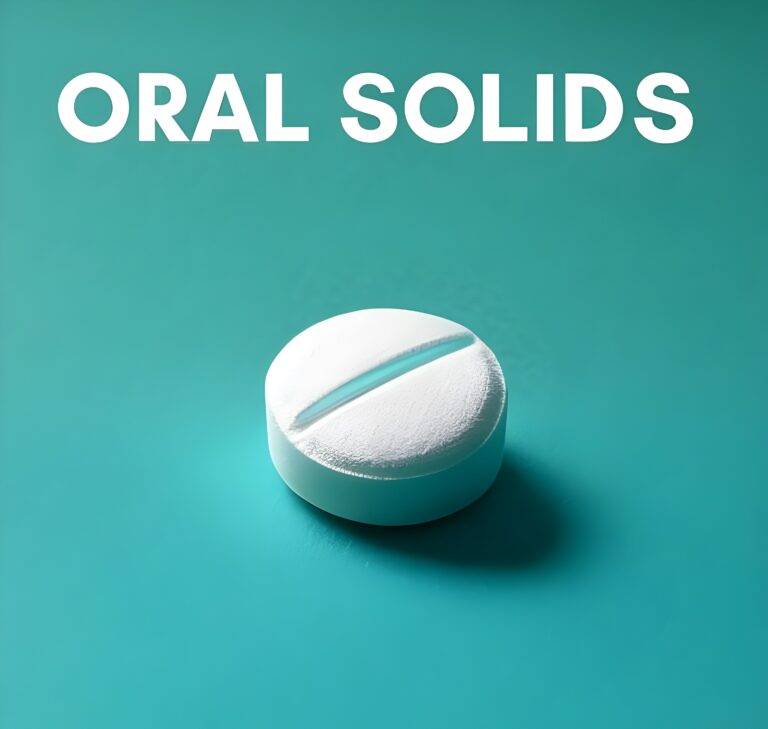Pharmaceutical mini tablets are solid oral dosage forms with a diameter less than or equal to 3 mm which makes them easier to swallow compared to conventional tablets and capsules. This makes them particularly suitable for pediatric and geriatric patients who may have difficulty swallowing larger dosage forms. They are essentially subunits of conventional tablets, designed to offer several advantages in drug delivery. The formulation development of mini tablets is similar to that of standard tablets, with the primary difference being the use of multiple punches during manufacturing.

An Overview of Minitablets
1. Ideal For Pediatric And Geriatric Dosage Forms
Mini tablets are particularly suitable for pediatric and geriatric patients. Their small size makes them easier to swallow compared to conventional tablets and capsules, improving patient compliance. This is crucial for populations that may have difficulty swallowing larger dosage forms.
2. Versatile Dissolution Profiles
Mini tablets can be formulated to meet a wide range of dissolution profiles, including delayed-release, controlled-release, and combination-release. This versatility allows for precise control over the drug’s release rate, enhancing therapeutic outcomes and reducing side effects.
3. Multiple Unit Dosage Forms
As multiple unit dosage forms, mini tablets offer several advantages over granules and pellets. They are easier to manufacture and more stable, ensuring consistent quality and performance. The uniformity in size and weight also contributes to reliable drug release.
4. Flexibility In Finished Dosage Forms
Mini tablets provide flexibility in the final dosage form. They can be delivered as capsules, sachets, or even compressed into larger tablets. This adaptability allows for customized drug delivery solutions tailored to specific patient needs and preferences.
5. Fixed Dose Combination Delivery
Mini tablet drug delivery systems are ideal for delivering fixed dose combination pharmaceutical oral solid forms. In drug product development, different types of mini tablets can be mixed with each other or with pellets, granules, or powders. This approach helps avoid incompatibilities in combination products and allows for the development of complex drug regimens.
6. Simplified Manufacturing Process
The manufacturing process for mini tablets is relatively straightforward. The use of multiple punches and advanced compression techniques simplifies production, making it easier to scale up and maintain consistent quality. This efficiency is beneficial for both large-scale manufacturing and small-batch production.
7. Enhanced Stability
Mini tablets are more stable than other dosage forms like granules and pellets. Their compact size and solid form reduce the risk of degradation and ensure a longer shelf life. This stability is essential for maintaining the efficacy and safety of the medication over time.
technologies involved in the formulation development of mini tablets
1. Increase in Productivity
The use of mini tablets can significantly enhance productivity in pharmaceutical manufacturing. The small size allows for high-speed production processes, reducing the time and resources required for each batch. Automated systems and advanced machinery can handle large volumes efficiently, leading to higher output rates.
2. Acceleration in Time to Market
Mini tablets can expedite the time-to-market for new drugs. The streamlined manufacturing processes, combined with the ability to produce multiple formulations simultaneously, enable faster development cycles. This is particularly beneficial for meeting urgent medical needs and staying competitive in the market.
3. Less Risk of Dose Dumping
One of the critical advantages of mini tablets is the reduced risk of dose dumping. The uniformity in size and weight ensures consistent drug release, minimizing the chances of sudden, uncontrolled release of the active pharmaceutical ingredient (API). This enhances the safety and efficacy of the medication.
4. Ease of Minitablet Manufacturing
The manufacturing of mini tablets is relatively straightforward compared to other dosage forms. The use of direct compression techniques and advanced granulation methods simplifies the production process. Additionally, the compact size of mini tablets allows for easier handling and packaging.
5. Ideal for Coating
Mini tablet drug delivery systems are particularly suitable for coating applications. The small surface area allows for uniform coating, which can be tailored to achieve specific release profiles. Coatings can be applied to protect the API from degradation, mask unpleasant tastes, or provide controlled release properties.
6. Versatile Release Profiles
Mini tablet formulation development can produce formulations with various release profiles, including immediate release, sustained release, and delayed release. This versatility allows for precise control over the drug’s pharmacokinetics, improving therapeutic outcomes and patient compliance.
7. High Drug Loading
Mini tablets can accommodate high drug loading, making them suitable for delivering potent medications in small doses. This is particularly advantageous for drugs with narrow therapeutic windows, where precise dosing is crucial. The ability to incorporate high amounts of API without compromising the tablet’s integrity is a significant benefit.
Technologies Involved In The Formulation Development Of Mini Tablets
In principle, mini-tablets development and formulation is similar to the larger, conventional tablet development and formulation. However, successful development of mini tablet drug delivery systems require specialist expertise as many drug product development issues are enhanced due to their small size. Mini tablet drug product development services are enabled by several tablet technologies developed for mini tablet development and formulation. Mini tablet pharmaceutical development services and the mini tablet formulation technologies that enable them, are explored below:
1. Dispensing
Dispensing is performed with the help of weighing and measuring apparatuses and aims to accurately weigh out API, excipients & other ingredients that make a tablet.
2. Sizing
Sizing is carried out to reduce and obtain the desired particle sizes before later stages of development of mini tablet formulations. Sizing is carried out with the help of fluid energy mills, colloidal mills, ball mills, etc.
3. Blending/Mixing
Blending or mixing is very important for the drug product development of oral solid dosage forms. Blending mini tablet drug product development services create homogenized mixtures for granulation followed by compression. Blending is carried out by using tumbling blenders, oblicone blenders, agitated powder blender and other mini tablet formulation technologies.
4. Granulation
Granulation creates aggregates of adhered pharmaceutical oral solid forms that are ready for compression. This mini tablet drug product development service is achieved with the help of fluidized bed granulators, roto granulators, high shear granulation mini tablet formulation technologies, etc.
5. Compression
Compression in mini tablet development and formulation is the stage at which fine powders and APIs are directly compressed for the development of mini tablet formulations. Compression mini tablet drug product development services are carried out with the help of rotary tablet press, multiple tip punch machines, etc.
6. Coating
During the development of mini tablet formulations, coatings are used to mask bitter taste and unpleasant odor of mini tablet pharmaceutical oral solid form to make them more suitable for consumption. This drug product formulation development service can be performed on fluidized bed coaters, perforated coating pans, standard pans, etc.
Evaluation of the physical and analytical properties of the mini tablets produced can help define the optimum drug formulation development route, composition, and processing window, and can be leveraged to assess manufacturing risks and risks associated with the corresponding mini tablets drug product development services. Many of the tests applied to larger-sized tablets can also be applied to mini tablets, although some modifications may be needed.
Related Services







FAQs
Here are some frequently asked questions about Semi-Solids & Gels
Semi-solid dosage forms include creams, ointments, gels, and pastes, designed for external application to the skin or mucous membranes. They are characterized by their thick consistency, which allows them to adhere to the application site for effective drug delivery. These dosage forms are used to treat a wide range of conditions, from skin diseases to localized pain relief.
Semi-solid dosage forms offer several benefits, including targeted drug delivery to specific areas, reduced systemic side effects, and enhanced patient compliance due to ease of application. They can provide both local and systemic effects, depending on the formulation, and are particularly useful for delivering drugs that are not suitable for oral administration due to stability or bioavailability issues.
The formulation of semi-solid dosage forms involves the selection of appropriate base materials (such as hydrocarbons for ointments, water or alcohol for gels, and various emulsifiers for creams) that determine the product's texture, stability, and drug release characteristics. Active pharmaceutical ingredients (APIs) are then incorporated into the base, along with other excipients like preservatives, antioxidants, and skin conditioners, to achieve the desired therapeutic effect and product stability.
Stability considerations for semi-solid dosage forms include maintaining the consistency, efficacy, and integrity of the product throughout its shelf life. This involves ensuring the physical stability (to prevent separation or crystallization of components), chemical stability (to prevent degradation of active ingredients), and microbiological stability (to prevent contamination). Stability testing under various conditions is critical to determining the product's expiration date.
Ensuring uniformity of dosage in semi-solid forms involves rigorous manufacturing processes and quality control measures. The manufacturing process must ensure thorough mixing and homogenization of the API throughout the base. Quality control tests, including content uniformity and viscosity measurements, are conducted on each batch to ensure that the final product meets the specified criteria for uniformity and consistency.
Yes, semi-solid dosage forms can be designed for controlled release of the active ingredient. This is achieved through the use of specific formulation strategies and excipients that modify the drug release profile, such as polymers that form a matrix with the drug or encapsulation techniques that slow the diffusion of the drug from the base. Controlled release formulations can enhance therapeutic efficacy and improve patient compliance by reducing the frequency of application.
Packaging options for semi-solid dosage forms include tubes, jars, pump dispensers, and single-use sachets. The choice of packaging is based on the product's viscosity, intended use, and stability requirements. Packaging materials must protect the product from contamination, light, and air, and be compatible with the formulation to prevent interaction with the packaging.
Quality assurance testing for semi-solid dosage forms includes physical, chemical, and microbiological tests. Physical tests evaluate the product's appearance, pH, viscosity, and spreadability. Chemical tests assess the potency and purity of the active ingredients and the presence of degradation products. Microbiological tests ensure the product is free from harmful microorganisms. All tests are conducted in accordance with regulatory guidelines to ensure product safety and efficacy.
c
Regulatory considerations for semi-solid dosage forms involve compliance with guidelines provided by regulatory agencies such as the FDA, EMA, and others. These guidelines cover the formulation, manufacturing process, quality control, packaging, labeling, and stability testing. The submission of a New Drug Application (NDA) or Abbreviated New Drug Application (ANDA) is required for market approval, including detailed documentation of the product's formulation, manufacturing process, and validation of analytical methods.
Hycon Labs offers comprehensive services for the development and manufacturing of semi-solid dosage forms, including formulation development, process optimization, scale-up, manufacturing, and packaging. Hycon can provide expertise in selecting appropriate base materials, excipients, and manufacturing processes to meet the product's specifications and regulatory requirements. Additionally, Hycon can assist with stability studies, quality assurance testing, and regulatory submission, facilitating a smooth path from concept to commercialization.






























